#guided birding in india
Explore tagged Tumblr posts
Text

The Ornithologist's Field Guide to Love
By India Holton.
13 notes
·
View notes
Text
Deepak Tal Tourist Spot in Lahaul and Spiti, Himachal Pradesh
Deepak Tal is a stunning lake located in the Lahaul and Spiti district of Himachal Pradesh, India. Known for its crystal-clear waters and breathtaking surroundings, this serene spot is perfect for nature lovers and those seeking tranquility. The area is surrounded by majestic mountains and lush greenery, making it one of the best offbeat places near Deepak Tal to explore. Visitors often find themselves captivated by the beauty of this hidden gem, making it a must-see destination in India.

Nearby, you can visit the beautiful Chandratal Lake, which is famous for its unique shape and vibrant blue waters. This high-altitude lake is a favorite among trekkers and photographers. Another great spot is the Kunzum Pass, which offers stunning views and is a gateway to many trekking routes. These are just a few of the places to visit near Deepak Tal that will leave you in awe of the natural beauty of the region.
For adventure enthusiasts, the trekking trails around Deepak Tal lead to incredible landscapes and rich wildlife. You can also explore the nearby village of Losar, known for its traditional culture and friendly locals. Whether you want to relax by the lake or embark on an adventure, Deepak Tal and its surroundings offer something special for every traveler.
#clearholidays#Deepak Tal#places to visit near Deepak Tal#Deepak Tal tourism#Deepak Tal travel guide#Himachal Pradesh#india#indian#travel#india travel#india tourism#incredible india#Lahaul and Spititourism#bespoke#beyonce#bibliophile#biology#birblr#birds
0 notes
Text
Himalayan Birding Tours | Bird Watching In Jim Corbett National Park
When it comes to birdwatching, few places on Earth rival the breathtaking beauty and biodiversity of the Himalayas. Nestled amidst towering peaks and verdant valleys, the Himalayan region offers birdwatchers a paradise teeming with avian wonders. Asian Adventures, a renowned name in eco-tourism and wildlife exploration, invites you to embark on an unforgettable journey into the heart of Himalayan Birding Tours.
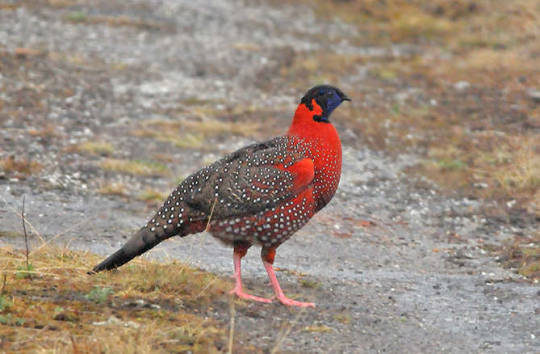
Why Choose Himalaya Birding Tours with Asian Adventures?
Expert Guidance: Asian Adventures prides itself on its team of expert naturalists and guides who have an intimate knowledge of the region's birdlife. From rare Himalayan species to migratory birds, our guides ensure a rewarding and insightful birdwatching experience.
Exclusive Access: Our Himalaya Birding Tours grant you access to some of the most pristine and lesser-explored birding hotspots in the Himalayas. Traverse dense forests, alpine meadows, and serene lakes, encountering a diverse array of feathered marvels along the way.
Tailored Itineraries: At Asian Adventures, we understand that every birdwatcher has unique preferences. That's why we offer customizable itineraries, allowing you to focus on specific bird species or explore multiple habitats during your tour.
Discovering Birdwatching India with Asian Adventures
Birdwatching in India is a captivating journey filled with surprises at every turn. As you venture into the diverse landscapes of this vast country, you'll encounter a spectacular variety of birds, each contributing to India's rich avifauna.
Himalayan Avifauna: The Himalayas are a treasure trove of avian diversity, with species like the Himalayan Monal, Snow Partridge, and Himalayan Griffon captivating birdwatchers with their beauty and grace. Our Himalaya Birding Tours take you to prime locations for spotting these and many other Himalayan gems.
Western Ghats Splendor: Venturing south, the Western Ghats beckon with their lush rainforests and endemic bird species. From the colorful Malabar Trogon to the majestic Great Hornbill, Birdwatching India in the Western Ghats is a feast for the senses.
Coastal Wonders: India's vast coastline is home to an impressive array of seabirds, shorebirds, and wetland species. Explore coastal lagoons, estuaries, and mangrove forests with Asian Adventures to witness the fascinating birdlife thriving in these habitats.
Embark on Your Birding Expedition with Asian Adventures
Whether you're a seasoned birder or a novice enthusiast, Asian Adventures ensures a memorable and enriching birdwatching experience in India's Himalayan region and beyond. Our commitment to sustainable tourism practices and conservation efforts ensures that future generations can also marvel at the splendor of India's avian treasures.
Join us on a Himalaya Birding Tour and discover the magic of Birdwatching India with Asian Adventures. Contact us today to plan your customized birding itinerary and immerse yourself in the captivating world of birds amidst breathtaking natural landscapes.
#pangot birds#himalaya birding tour#birding in india#bird watching and birding photography#birding guide#birding destinations in uttarakand#himalaya birding tours
0 notes
Text
#LongPost: A Few Hyper-Specific Things About India for India-Based Stories and Art
No this isn't a cry for more Indian-rep in Spider-Verse stories. (It is.)
Anyway. I recently went to India, and after returning to my hometown in Tamil Nadu, I reintegrated a whole slew of memories and collated new facts.. And considering I've been wanting to do one of these for quite some time (and because I need a new variety of Pavitr Prabhakar content), I thought it'd be cool if I shared some of my experiences and ideas with you.
It's best to take this with caution, though: the only places I've been to are Tiruchirappalli, Madurai, and a few towns located close to the Eastern Ghats, so my knowledge is heavily South India-based. I know for a fact that there are various similarities and differences between other geo-cultural areas of India, which is I why I've linked the other cool India Resources here as well.
In Which I Ramble About Pavitr's Character Design and the Indian Cultural Stuff Related to It by @chaos-and-sparkles (+ my addition + @neptune432's addition)
A culture post for the girlie pops (and non-girlie pops) looking to write Pavitr Prabhakar accurately by @summer-blues-stuff (+ my addition + @fandomsfeminismandme addition)
Also a timely reminder of @writingwithcolor's wonderful resources on writing about South Asian characters respectfully and sincerely
Now, for the things I've noticed in South India..
ANIMALS
There are a lot of street dogs. Like... a lot of them. And honestly it's so hard not to go up to one and give them a snack or two. The most notable dog breed is the Indian pariah and they can be found all over India. Mixed dog breeds are also common and results in a variety of features like differences in build and coat colours.


There are also other types of animals are pretty common to see alongside the roads.
Cattle are seen a lot (cows and bulls are easy to distinguish; cows (left) have udders and a small hump on their back, while bulls (right) are generally stockier and have a super-defined hump on their back). I'm pretty sure the specific cow breed is the sahiwal cow. They are either herded into paddocks for grazing or can be found wandering city streets on their own.


Goats are often herded by farmers into large masses of wool and horns and are guided to paddocks to graze. Sometimes, like cattle, they'll be found wandering city streets on their own.
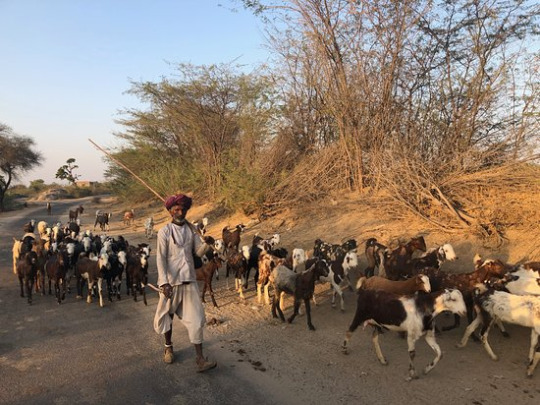
Chickens are usually kept close to stalls and homes. These chickens are not plump and fluffy like most Western chickens, but are quite skinny. Mottled feather colours are usually a result of mixed chicken breeds. In Tamil Nadu, the most common chicken breed is the asil chicken.
Various birds are often seen flying around traffic if they’re not disappearing into the sky, the most common being crows, pigeons and mynahs. (The chart below on the right is not an inexhaustive list of birds; you best search them up yourself.)
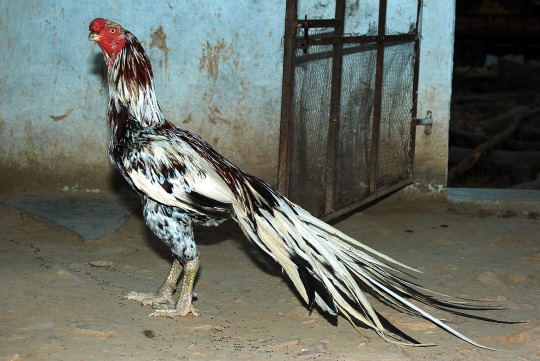
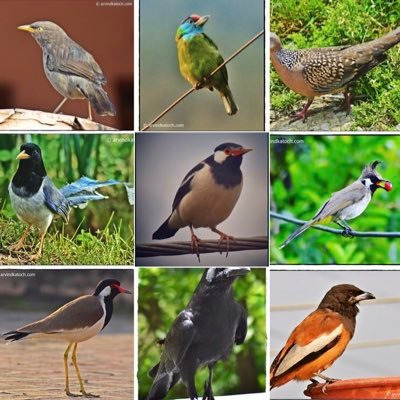
TRANSPORT
There is obviously a huge amount of trucks and lorries and buses. They all have beautiful designs or crazy LEDs or large detailed fluorescent / iridescent stickers that are impossible to ignore, whether it be at high noon or midnight.


Expanding on that, the most common method of transport are motorcyclse or scooties, cars, and autos.
Also, as expected: traffic is insane. It’s horrible. It’s exhilarating. Western honking is akin to swearing, but here? Honk whenever you want. Honk if you’re happy or if you’re sad. You get a million dollars if you honk. You need to honk. It’s more important than breathing
Similarly, road rules don’t exist. Well, they do, and the Indian government does everything it can to make sure people do follow the rules, but based on the aforementioned honking, most people don't. Everyone just drives. Most bikers and motorcyclists don’t wear helmets. Only a few people wear seatbelts. Cars and motorcycles drive on the wrong side of the road and right into oncoming traffic. The chance of someone dying is 99% but it’s countered by desi stubbornness.

ENVIRONMENT & INFRASTRUCTURE
Houses and buildings are painted different colours!!! Pastel pinks and purples and deep teal hues, either plain colours or decorated with elaborate murals. This also applies to interiors. I reckon it was surprising to a lot of people when they were confronted with Mumbattan's vibrant colours, but honestly: coloured buildings slap, and it's based on the real thing. They are a sight to behold. Couple that with the architecture and oh boy- you've got such a beautiful environment.







From @jettpack's concept art for Mumbattan buildings

jettpack's concept art of the Mumbattan collider


From @chenfelicia's concept and colour keys of Mumbattan
Don't be shy to really immerse in crazy descriptors - that's how you capture the liveliness of cities like Madurai and Mumbai and ultimately, their physical manifestations like Mumbattan.
Funny enough, movie posters and political banners and flyers are EVERYWHERE. They’re huge and take up entire billboards, or congregate along walls so it becomes practically a collage. It's impossible to ignore the image of "Makkal Selvan" Vijay Sethupathi about to beat some poor loser into a pulp with a stick, or the political parties roasting each other on paper with impressive photoshopped graphics.


To tie in to the point about transport: there are hundreds of coffee stalls and snack shops and one-of-a-kind food stands. You can’t go 200 metres without running into one, either on the highway or in the city. I remember having jaggery coffee on my first night in India, and guys- it tasted so fucking good. I only wish I can transfer the taste to you. Absolutely splendid.
The climate in India is generally very humid and warm, but that doesn't mean we don't get cooler days; it is obviously cooler on winter nights. Also I've heard from many conflicting sources on India's seasonal weather (probably due to India's geograpghy), so you will have to talk to someone who is from India to really confirm. I've somewhat boiled it down to five seasons:
Summer - May-Jun; very hot (35-45ºC/95-113ºF), characterised by shrinking water bodies and droughts if there aren't any rainfalls; this time is good for plant growth/harvest if you've successfully managed water supplies
Monsoon - Jul-Aug; (34ºC/93ºF) very variable in terms of timing, characterised by torrential rains and floodings; the raining itself probably lodges somewhere in Jun-Sept but the aftereffects are felt long after the rains have stopped
Autumn - Sept-Nov; cooler but humid (25-35ºC/77-95ºF), and generally much drier since it transitions from autumn to winter
Winter - Dec-Feb; much colder, but the extent is dependent on geographic regions (20-25ºC/68-77ºF)
Spring - Mar-Apr; humid (33ºC/91ºF), sudden downpours, only occasionally do you get pleasant weather in this time
PEOPLE AND CULTURE
For some reason, there are still loud speakers blaring out music across the roads and as far as a few city blocks. I honestly thought that that had died out by the time my parents had graduated university, but it still seems like people like hearing music played at 120 decibels.
This is a complicated issue but people are not piss poor. Yes, India is a developing country, and yes there are slums and there are homeless and there are those who are stuck in a horrific sociocultural cycle, but people are rapidly getting into high-paying jobs at much higher rates than before. Overall, India is getting better; do us a favour and not have us be represented by the same poor struggle-riddled Indian stories that Hollywood and Western media is are fond of portraying.
@neptune432: One thing I think it's important to acknowledge though is how your experience in India changes depending on your caste. I feel like most of the indian voices talking online are savarna (I'm not an exception) so this doesn't get brought up as much. It's a complicated issue and one that I don't think non-indians (or savarna indians) should worry about tackling in their work, but it's worth saying because what's assumed to be everyday aspects of indian culture are actually specific to things like caste, class, and what region you're in. ex: in kerala, there are also examples of people eating on banana leaf with lots of vegan food for special occasions (namely during onam). but veganism is heavily tied to brahmanism so most of these people will be savarna. even if they eat meat otherwise, the specific interest in eating vegan for special occassions has clear implications. Though many people of different castes eat meat, it's a practice that gets discriminated against, being treated as barbaric and unclean. this is because of brahmanism and is usually only strictly followed by brahmins. dalits/bahujan usually face the worse treatment for their eating traditions. there's also the fact that hinduism is more of a recent term and a broad umbrella where many different gods and cultures have been put under (and usually done forcefully). a lot of local dieties and specific cultural practices come from outside the vedic traditions of aryans (upper caste north india), but now are treated almost as one thing. ex: kali is a south indian (dravidian) goddess who's still heavily worshipped there and who later got adapted to brahminical traditions. that's also why south indian practices of worship are different from the north and are discriminated against ex: north indians getting angry at the idea of worshipping kali by drinking alcohol and smoking even though it's an older tradition than theirs. these traditions are often connected to dalit/tribal cultures as well, which adds to why these traditions are attacked. Now, I don't feel comfortable with non-indians writing about india in general but I feel it's important to mention these things cos most people don't even realize they're only getting shown certain perspectives. How many people don't even know they're a north/south divide, for example? People are fed narrow viewpoints on India and assume that's everything to know. it's a problem cos that's what the brahminical forces in india want. This is all very general info too and I'm no expert so it's worth more research (like reading what dalits have said on their experiences). I'm not trying to criticize you btw, I just wanted to add some things cos this has been on my mind for a long time now. Couldn't have said it better myself, neptune!! (I barely mentioned it at all lmao) The caste system despite it being "abolished" still defines many traditions within India, and almost always in harmful ways. Like @summer-blues-stuff and I have mentioned in their post A culture post for the girlie pops under the Religion and caste section, it's best to leave the caste and social hierarchy alone even if you've done your research. That doesn't mean you shouldn't talk about it, it's just that people, especially those of non-South Asian decent, have to be extremely careful about it. Introductory resources on the caste system can be found on ABC, Pew Research and The Conversation.
Furthermore, the automatic assumption is that people living in shacks or remote villages have no access to greater populations and resources, which I'm happy to completely disprove. Guys: majority of the people living in my village, a rather remote village, have phones on them. Ranges from iPhones to Androids to good ol' Nokias.
(And, side note: as an Indian, I get amazingly pissed off when people's ringtones are set to maximum volume and play the same famous part of a famous song every time they get a call. Like shut the fuck up. At least quieten down? Please??)
(Also this might be a South Indian thing but Man some people are so entitled. Dudes you do not need to rub your ego into my face. Dudes you can, you know, keep all the cool things you think will get other people jealous out of the public eye. At this point I'm not jealous of what you Have, I'm pissed off at the Audacity To Think You Can Make Me Feel Bad About Myself With The Things That You Have).
Alright. Moving on.
Tiny temples and shrines are everywhere, dedicated to broad-Hinduism deities like Ganesh, Shakthi, or Vishnu; other times, they are shrines built for local deities that protect a particular village. For example, my village dedicated a little plot of water-logged land to a benevolent spirit called Subbamma, where people would leave offerings or place their sick/injured animals at the water's edge so that Subbamma could heal them. These tiny temples are almost always super colourful and amazingly detailed despite their small size
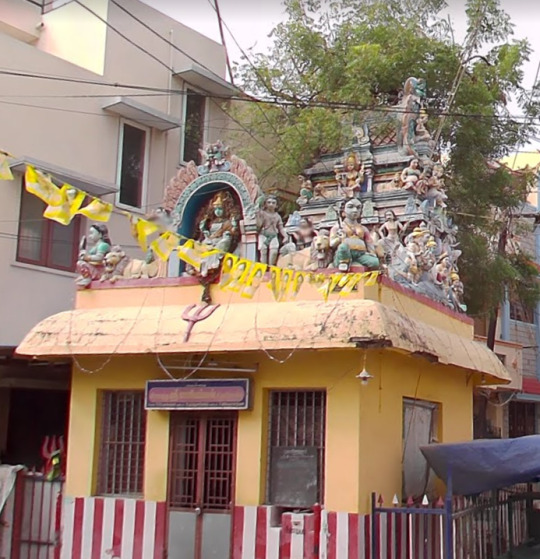
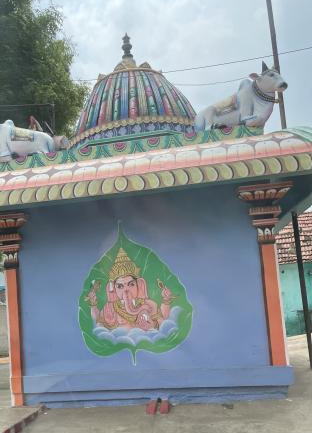
It could be a whole month before a celebration like Diwali but it’s the perfect time to set off hundreds of fireworks and firecrackers. People are just inconsiderate in many ways, it seems.
Some women wear strings of jasmine flowers in their hair. This might be completely regional-based, but most if not all women, ranging from little kids to old ladies, will wear these strings of jasmine in their hair. It's supposed to represent good fortune and beauty, and it smells wonderful.
@esrev-redips: #i usually only visit the north side of india (went to banglore and or chennai once) but im pretty sure most women in mumbai wouldnt wear #flowers in their hair unless they were of an older generation #they dont in new delhi at least and i t h i n k you can compare them but im not sure since i dont live in india either Thank you esrev!!!!! glad to see an old hunch be confirmed!!!


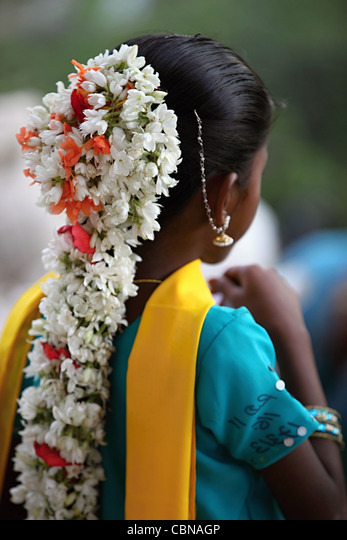
Normally you can wear any type of jasmine, but the common subtypes in Tamil Nadu are ஜாதிமல்லி (jathimalli; "Spanish jasmine"; left) and மல்லிப்பூ (mallipoo; right).

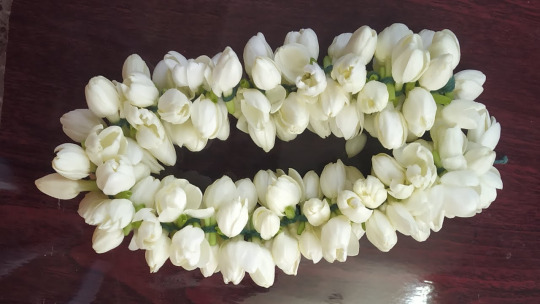
Eating food from a plate made from a banana leaf is more than just an aesthetic, and is often reserved for certain occasions; other times we eat from metal or ceramic plates. I can't vouch for other areas of India but I've been told the reason why banana leaves are predominantly used for large gatherings is because they can signal to diners if the food is rotten or has been poisoned; supposedly the leaf itself starts rotting and releases liquid, but I personally have never seen this happen. But of course, there are also other reasons as to why banana leaves are used (all of which are valid) ranging from being an eco-friendly disposable plate, offloading nutrients into food, or even to make the food taste better. Pick whichever reason you like.
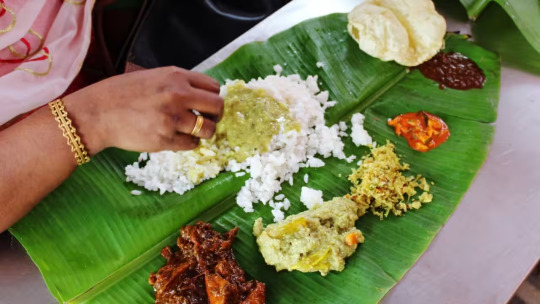
I'm literally so hungry looking at this. (Realises this is a Pavitr thing to say.) Anyway.
FOOD RECS!!!!!!
Reblog with your favourite foods >:) The list will be routinely updated...
JAGGERY COFFEE (from me) - GOOD FUCKING STUFF. ACTUALLY. if you see it.. GET IT IMMEDIATELY
PANI PURI (from @esrev-redips) - #also you forgot to mention the PANI PURI STANDS AHHHHHH YUMYUMYUM | RRRR YOU'RE SO RIGHT. PANI PURI FOR LIFE ACTUALLY.
JASUBEN PIZZA (from @the-witch-forever-lives) - okay this is specific to Ahmedabad | okay but as specific as it may be that sounds and looks delicious??? hello??????
DABELI (from @the-witch-forever-lives) - this too???? also it LOOKS wonderful i need it right now actually
VADA PAV (from @the-witch-forever-lives) - Also Vada pav from Mumbai is so one of a kind | you are absolutely correct. vada pav is truly something magnificent
I think that's about all I can give you right now. This took me a while to type out. Feel free to ask any questions, or if you have anything you would like to add on, like anything I might have glossed over or your favourite desi foods, please do!!! I'll be sure to reblog your addition and update the original post.
The point is that this post can become one of those few other reference posts that artists and writers and other creatives can use if they ever want to make anything related to India, because it's genuinely so cool to see your culture represented so well in popular modern media.
(And in fanfic and fandom. Especially in fanfic and fandom. you have no idea how many times I've gone insane reading a Pavitr-centric fic or reading comments on Pavitr-related posts and it's just outdated ideas and harmful stereotypes and all sorts of sick bullshit, and it's always to the point where I physically have to go outside and bite into a fresh rhizome in order to ground myself. Like damn, people, you need to know things before you start creating)
So uh, I hope this was helpful if not interesting! Happy early Diwali everyone! Knowledge-over-ignorance and all that; hopefully this post does that notion justice!
#pavitr prabhakar#wrote this solely because i wanted more atsv pavitr-centric fics and i need to get that specific immersed-in-india itch scratched#and also because the india i remembered decades ago is definitely not the india i visited last week#wow time flies doesn't it#spider man india#india#writing tips#o wise writer stuff#indian culture#south asian culture#spider man across the spider verse#atsv#across the spider verse#chaipunk#goldenpunk#cultural references#atsv pavitr#agnirambles
220 notes
·
View notes
Text
Here's the discussion for Umemiya's deity representation as seen in the latest chapter. If you haven't seen my thoughts on Takiishi's yet then I've provided a link to that post as well.
(I hope you appreciate the better quality & organization of the post from my well-rested brain cells)
Part 1: Takiishi Chika and the Karura
Spoilers for Chapter 150!




In my last post, I discussed my theory that the bird-like deity depicted for Takiishi was a karura. With Umemiya, I believe the deity to be Fudō Myō-ō (不動明王, ふどうみょうおう) who is also known as the Immovable Wisdom King (Skt. Ācalanātha).


[Fudō Mask was sourced from the Japanese Buddhist Statuary: A to Z Phot Dictionary; (Wooden) Seated Fudō Myō-ō Statue by Kaikei created in 1203 sourced from Isumu (360° view available)]
Fudō Myō-ō is THE central deity among all of the Myō-ō (warlike or wrathful gods) groupings, but is most prominently featured among the Godai Myō-ō (五大明王, Five Great Kings) who are manifestations of the Five Transcendental Buddha. He was given the title as the Immovable One due to his unwaivering commitment to the protection of Buddhist teachings.
Orginating as a pagan deity from India, Fudō's conversion to Buddhism began with humble beginnings. He was assigned as a servant and messenger of Buddha himself and later achieving higher positions—becoming a manifestation of the power and virtues of Dainichi Buddha, one of the 5 Transcendental Buddha I mentioned previously. (Source: MetMuseum)
In regards to their appearances, Fudō shares a remarkable resemblance to the deity depicted in Chapter 150. From his adornments, eyebrows, hair style, the prominent scowl etched into their faces and the long side braid (?) to the left of the face.
Aside from looks, let's talk about the prominent parallels between Umemiya and Fudō Myō-ō:
Origins. Both Ume and Fudō had to start over with their lives, with Ume losing his family due to a car accident and Fudō being stripped of his former godhood after converting to Buddhism. Despite these, they were able to work their way up so they'll be strong enough to protect what they valued the most.
Their roles. According to Schumacher in his page about Fudō,
"Fudō converts anger into salvation..."
- Schumacher, M., "Fudō Myō-ō"
"converts anger into salvation", that seems familiar- Oh wait.




Fudō and Ume are guides to enlightenment AND protectors. They themselves are symbols of safety in the eyes of those under their care.
Connections. While the Godai Myō-ō (Five Great Kings) aren't closely related to the Shitennō (Four Heavenly Kings) as the former rank far above the latter, there are similarities to be found. One is that both groups are in charge of the five directions, and yes five. The Shitennō is commanded by Taishakuten (帝釈天) who is the Lord of the Center. Relating this back to Ume and his Four Kings, it's interesting to note that the mangaka choose a higher ranking god to represent Ume rather than use Taishakuten. Perhaps to differentiate the power gap between Umemiya and his Four Kings?
Conclusion: I'm confident that Fudō Myō-ō is definitely the god representing Umemiya with the evidence I have gathered as well as several others have come to similar conclusions to the fact. It was really fun deep diving into this research for both Takiishi and Umemiya and with a clear head than the previous post, perhaps I'd like to make another one but of Tomiyama and Togame (The Hare & The Tortoise) or Sakura and Sugshita (The Tiger & The Dragon). No promises though.
(P.S. I am not Japanese but I have been deeply interested in the culture and history. I do my best to use credible sources (both ENG and JPN) and give credit accordingly. However, I'm prone to slip ups so if there is anything that requires correction, notify me throught the post via reply/reblog.)
(P.S.S. I have a blog specifically made for wbk content for further post like this so feel free to visit me there @transient-winds )
#OKAY ITS DONE#*dies promptly*#see what happens when im not running on no sleep & food#umemiya the man u are#i understand the appeal tsubakino#wind breaker#wind breaker nii satoru#wind breaker chapter 150#umemiya hajime#hajime umemiya#takiishi chika#chika takiishi#umemiya vs takiishi fight
49 notes
·
View notes
Text
Currently reading: India Holton’s The Ornithologist’s Field Guide to Love and 12/10 no notes.
This book has everything—rivals-to-lovers! Magical birds! Whimsy! Smugglers! Academic peers who can’t stand each other! Young professors just trying to get tenure so they can research what they want! Secret shadowy individuals working behind the scenes to rig a competition for the best publicity! A+ all around.
40 notes
·
View notes
Text
BOTD: Rock Pigeon
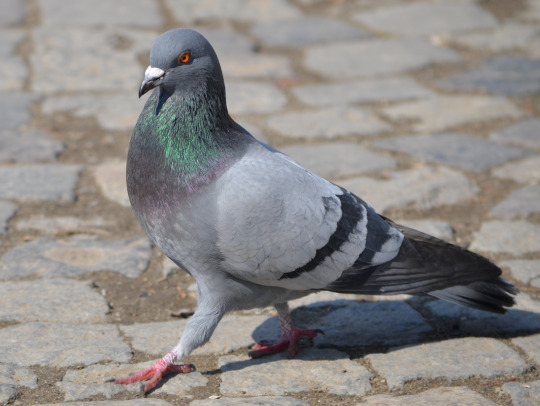
Photo: Razvan Socol
"Few birds have been associated with humans so closely as the Rock Pigeon, better known as the common city pigeon. It has been domesticated and taken around the world, raised for food, trained for homing, racing, and carrying messages, and used in research. Originally native from Europe to North Africa and India, it now lives in a wild or semi-wild condition in cities all over the world, including most of North America. In places it has reverted to wild habits, nesting on cliffs far from cities."
- Audubon Field Guide
#birds#rock pigeon#birds of north america#north american birds#pigeons#doves#birds of the us#birds of canada#birds of mexico#birds of central america#birds of the caribbean#birding#birdblr#birblr#bird of the day#bird watching#Columba livia
123 notes
·
View notes
Text

Agni Dev Talon Abraxas
Agni Dev: Exploring the Sacred Fire God of Hindu Mythology
When we talk about the Hindu pantheon, one name that stands out is Agnidev, the god of fire. Agni, as he’s often called, plays a vital role in Hindu mythology and rituals. From sacrificial fires to the flames of a domestic hearth, Agni is everywhere. Let’s delve into the captivating world of Agnidev and understand his importance in Hindu culture.
The Many Faces of Agni
Agni isn’t just about the fire we see every day. He’s associated with various forms of fire, including:
The Sun: The ultimate source of light and heat. Lightning: A powerful, natural force. Comets: Celestial fireballs streaking across the sky. Sacrificial Fire: Central to Vedic rituals. Domestic Fires: The heart of every home. Funeral Pyres: Guiding souls to the afterlife. Digestive Fire: The inner energy within all living beings.
During the Vedic period (1500-500 BCE), Agni was one of the most revered deities, and the Vedas contain more hymns dedicated to him than to any other god. Even today, though not directly worshipped as much, Agni is omnipresent in various Hindu ceremonies, especially marriages and other significant rites of passage.
Agni’s Mythical Tales
Agni’s mythology is rich and varied. He is known to be the son of the Celestial Waters, symbolizing the connection between water and fire. When it rains, the fire is believed to descend to earth, only to rise again through vegetation. This cycle is a beautiful representation of the balance in nature.
One of the fascinating tales involves Agni’s reluctance to take on the duty of carrying offerings to the gods, fearing the same fate as his three brothers who perished while performing the task. To escape this duty, Agni hid in various places but was eventually discovered each time by different creatures. His final refuge, a sami tree, became sacred in Hindu rituals, with its sticks used to kindle fires. Despite his initial reluctance, Agni negotiated to receive a share of the sacrifices and was granted everlasting life.
agni dev
Agni in Hindu Art
In Hindu art, Agni is depicted in various forms:
Appearance: Agni often has black skin, two heads, four arms, and rides a goat or a chariot drawn by red horses. His two heads represent the domestic and sacrificial fires.
Symbols: He carries a fan, a sacrificial ladle, an axe, and a flaming torch or javelin.
Depictions: Sometimes shown as the Garuda bird or a goat-headed merchant, representing his role in sacrifices.
Agni’s artistic representations are not just symbolic but also a way to visualize his multifaceted nature.
Agni’s Role in Rituals and Daily Life
Agni’s presence is essential in many Hindu rituals. As a mediator between gods and humans, he carries offerings to the deities and brings their blessings to the worshippers. His role is so crucial that no significant Hindu ceremony, be it a wedding or a funeral, is complete without invoking Agni.
Agni is also considered the guardian of the southeast direction in Hindu cosmology, protecting this space as one of the eight guardians of directions (Dikpalas).
The Legacy of Agni
Over time, Agni’s prominence as a god has waned somewhat, but his legacy endures. His significance is captured beautifully in various Hindu scriptures, including the Mahabharata, the Vishnu Purana, and the Agni Purana. Agni’s tales, from his mythical origins to his role in epic battles and ceremonies, continue to inspire and fascinate.
Even today, the worship of Agni promises prosperity, protection, and a long life. Offering food and sacrifices to Agni ensures his blessings, safeguarding homes and families. The Agni Puran remains a vital source of these traditions, emphasizing Agni’s role and importance in rituals and daily life.
The Everlasting Flame of Agni
Agni, the Hindu god of fire, remains a powerful symbol of transformation, purification, and connection between the divine and the earthly. His presence in rituals underscores the importance of fire in Hindu culture, symbolizing life, death, and rebirth. As we light a fire, be it in a ritual or a simple hearth, we are reminded of Agni’s enduring presence and his vital role in the tapestry of Hindu mythology.
21 notes
·
View notes
Text
Countries that are no more: Achaemenid Empire (550BC-330BC)
It was not the first empire of Iranian peoples, but it arose as probably the greatest in terms of influence and became the measure by which all subsequent Iranian empires tended to compare themselves and its influence on culture, government & civil infrastructure would influence others beyond the span of its territory and the span of time. This is the Achaemenid Empire.
Name: In Old Persian it was known as Xšāça or the "The Kingdom or the Empire", it was named the Achaemenid Empire by later historians. Named after the ruling dynasty established by its founder Cyrus the Great who cited the name of his ancestor Haxāmaniš or Achaemenes in Greek as progenitor of the dynasty. It is sometimes also referred to as the First Persian Empire. The Greeks simply referred to it as Persia, the name which stuck for the geographic area of the Iranian plateau well into the modern era.
Language: Old Persian & Aramaic were the official languages. With Old Persian being an Iranian language that was the dynastic language of the Achaemenid ruling dynasty and the language of the Persians, an Iranian people who settled in what is now the southwestern Iranian plateau or southwest Iran circa 1,000 BC. Aramaic was a Semitic language that was the common and administrative language of the prior Neo-Assyrian & Neo-Babylonian Empires which centered in Mesopotamia or modern Iraq, Syria & Anatolian Turkey. After the Persian conquest of Babylon, the use of Aramaic remained the common tongue within the Mesopotamian regions of the empire, eventually becoming a lingua franca across the land. As the empire spread over a vast area and became increasingly multiethnic & multicultural, it absorbed many other languages among its subject peoples. These included the Semitic languages Akkadian, Phoenician & Hebrew. The Iranian language of Median among other regional Iranian languages (Sogdian, Bactrian etc). Various Anatolian languages, Elamite, Thracian & Greek among others.
Territory: 5.5 million kilometers squared or 2.1 million square miles at its peak circa 500BC. The Achaemenid Empire spanned from southern Europe in the Balkans (Greece, Bulgaria, European Turkey) & northwest Africa (Egypt, Libya & Sudan) in the west to its eastern stretches in the Indus Valley (Pakistan) to parts of Central Asia in the northeast. It was centered firstly in the Iranian Plateau (Iran) but also held capitals in Mesopotamia (Iraq). Territory was also found in parts of the Arabian Peninsula & the Caucausus Mountains.
Symbols & Mottos: The Shahbaz or Derafsh Shahbaz was used as the standard of Cyrus the Great, founder of the empire. It depicts a bird of prey, typically believed to be a falcon or hawk (occasionally an eagle) sometimes rendered gold against a red backdrop and depicts the bird holding two orbs in its talons and adorned with an orb likewise above its head. The symbolism was meant to depict the bird guiding the Iranian peoples to conquest and to showcase aggression & strength coupled with dignity. The imperial family often kept falcons for the pastime of falconry.
Religion: The ancient Iranian religion of Zoroastrianism served as the official religion of the empire. It was adopted among the Persian elite & and had its unique beliefs but also helped introduce the concept of free-will among its believers, an idea to influence Judaism, Christianity & Islam in later centuries. Despite this official religion, there was a tolerance for local practices within the subject regions of the empire. The ancient Mesopotamian religion in Babylon & Assyria, Judaism, the Ancient Greek & Egyptian religions & Vedic Hinduism in India was likewise tolerated as well. The tolerance of the Achaemenids was considered a relative hallmark of their dynasty from the start. Famously, in the Old Testament of the Bible it was said that it was Cyrus the Great who freed the Jews from their Babylonian captivity and allowed them to return to their homeland of Judea in modern Israel.
Currency: Gold & silver or bimetallic use of coins became standard within the empire. The gold coins were later referred to as daric and silver as siglos. The main monetary production changes came during the rule of Darius I (522BC-486BC). Originally, they had followed the Lydian practice out of Anatolia of producing coins with gold, but the practice was simplified & refined under the Achaemenids.
Population: The estimates vary ranging from a low end of 17 million to 35 million people on the upper end circa 500BC. The official numbers are hard to determine with certainty but are generally accepted in the tens of millions with the aforementioned 17-35 million being the most reasonable range based on available sources.
Government: The government of the Achaemenid Empire was a hereditary monarchy ruled by a king or shah or later referred to as the ShahanShah or King of Kings, this is roughly equivalent to later use of the term Emperor. Achaemenid rulers due the unprecedented size of their empire held a host of titles which varied overtime but included: King of Kings, Great King, King of Persia, King of Babylon, Pharaoh of Egypt, King of the World, King of the Universe or King of Countries. Cyrus the Great founded the dynasty with his conquest first of the Median Empire and subsequently the Neo-Babylonians and Lydians. He established four different capitals from which to rule: Pasargadae as his first in Persia (southwest central Iran), Ecbatana taken from the Medians in western Iran's Zagros Mountains. The other two capitals being Susa in southwest Iran near and Babylon in modern Iraq which was taken from the Neo-Babylonians. Later Persepolis was made a ceremonial capital too. The ShahanShah or King of Kings was also coupled with the concept of divine rule or the divinity of kings, a concept that was to prove influential in other territories for centuries to come.
While ultimate authority resided with the King of Kings and their bureaucracy could be at times fairly centralized. There was an expansive regional bureaucracy that had a degree of autonomy under the satrapy system. The satraps were the regional governors in service to the King of Kings. The Median Empire had satraps before the Persians but used local kings they conquered as client kings. The Persians did not allow this because of the divine reverence for their ShahanShah. Cyrus the Great established governors as non-royal viceroys on his behalf, though in practice they could rule like kings in all but name for their respective regions. Their administration was over their respective region which varied overtime from 26 to 36 under Darius I. Satraps collected taxes, acted as head over local leaders and bureaucracy, served as supreme judge in their region to settle disputes and criminal cases. They also had to protect the road & postal system established by the King of Kings from bandits and rebels. A council of Persians were sent to assist the satrap with administration, but locals (non-Persian) could likewise be admitted these councils. To ensure loyalty to the ShahanShah, royal secretaries & emissaries were sent as well to support & report back the condition of each satrapy. The so called "eye of the king" made annual inspections of the satrapy to ensure its good condition met the King of Kings' expectations.
Generals in chief were originally made separate to the satrap to divide the civil and military spheres of government & were responsible for military recruitment but in time if central authority from the ShahanShah waned, these could be fused into one with the satrap and general in chiefs becoming hereditary positions.
To convey messages across the widespread road system built within the empire, including the impressive 2,700 km Royal Road which spanned from Susa in Iran to Sardis in Western Anatolia, the angarium (Greek word) were an institution of royal messengers mounted on horseback to ride to the reaches of the empire conveying postage. They were exclusively loyal to the King of Kings. It is said a message could be reached to anywhere within the empire within 15 days to the empire's vast system of relay stations, passing message from rider to rider along its main roads.
Military: The military of the Achaemenids consisted of mostly land based forces: infantry & cavalry but did also eventually include a navy.
Its most famous unit was the 10,000-man strong Immortals. The Immortals were used as elite heavy infantry were ornately dressed. They were said to be constantly as 10,000 men because for any man killed, he was immediately replaced. Armed with shields, scale armor and with a variety of weapons from short spears to swords, daggers, slings, bows & arrows.
The sparabara were the first line of infantry armed with shields and spears. These served as the backbone of the army. Forming shield walls to defend the Persian archers. They were said to ably handle most opponents and could stop enemy arrows though their shields were vulnerable to enemy spears.
There was also the takabara light infantry and though is little known of them it seems they served as garrison troops and skirmishers akin to the Greek peltast of the age.
The cavalry consisted of four distinct groups: chariot driven archers used to shoot down and break up enemy formations, ideally on flat grounds. There was also the traditional horse mounted cavalry and also camel mounted cavalry, both served the traditional cavalry functions and fielded a mix of armor and weapons. Finally, there was the use of war elephants which were brought in from India on the empire's eastern reaches. These provided archers and a massive way to physically & psychologically break opposing forces.
The navy was utilized upon the empire's reaching the Mediterranean and engaged in both battles at sea and for troop transport to areas where troops needing deploying overseas, namely in Greece.
The ethnic composition of Achaemenid military was quite varied ranging from a Persian core with other Iranian peoples such as the Medians, Sogdian, Bactrians and Scythians joining at various times. Others including Anatolians, Assyrians, Babylonians, Anatolians, Indians, Arabs, Jews, Phoenicians, Thracians, Egyptians, Ethiopians, Libyans & Greeks among others.
Their opponents ranged from the various peoples they conquered starting with the Persian conquest of the Medians to the Neo-Babylonians, Lydians, Thracians, Greeks, Egyptians, Arabs & Indians and various others. A hallmark of the empire was to allow the local traditions of subjugated areas to persist so long as garrisons were maintained, taxes were collected, local forces provided levies to the military in times of war, and they did not rebel against the central authority.
Economy: Because of the efficient and extensive road system within the vast empire, trade flourished in a way not yet seen in the varied regions it encompassed. Tax districts were established with the satrapies and could be collected with relative efficiency. Commodities such as gold & jewels from India to the grains of the Nile River valley in Egypt & the dyes of the Phoenicians passed throughout the realm's reaches. Tariffs on trade & agricultural produce provided revenue for the state.
Lifespan: The empire was founded by Cyrus the Great circa 550BC with his eventual conquest of the Median & Lydian Empires. He started out as Cyrus II, King of Persia a client kingdom of the Median Empire. His reign starting in 559BC. Having overthrown and overtaken the Medians, he turned his attention Lydia and the rest of Anatolia (Asia Minor). He later attacked the Eastern Iranian peoples in Bactria, Sogdia and others. He also crossed the Hindu Kush mountains and attacked the Indus Valley getting tribute from various cities.
Cyrus then turned his attention to the west by dealing with the Neo-Babylonian Empire. Following his victory in 539BC at the Battle of Opis, the Persians conquered the Babylonia with relative quickness.
By the time of Cyrus's death his empire had the largest recorded in world history up to that point spanning from Anatolia to the Indus.
Cyrus was succeeded by his sons Cambyses II and Bardiya. Bardiya was replaced by his distant cousin Darius I also known as Darius the Great, whose lineage would constitute a number of the subsequent King of Kings.
Darius faced many rebellions which he put down in succession. His reign is marked by changes to the currency and the largest territorial expansion of the empire. An empire at its absolute zenith. He conquered large swaths of Egypt, the Indus Valley, European Scythia, Thrace & Greece. He also had exploration of the Indian Ocean from the Indus River to Suez Egypt undertaken.
The Greek kingdom of Macedon in the north reaches of the Hellenic world voluntarily became a vassal of Persia in order to avoid destruction. This would prove to be a fateful first contact with this polity that would in time unite the Greek-speaking world in the conquest of the Achaemenid Empire. However, at the time of Darius I's the reign, there were no early indications of this course of events as Macedon was considered even by other Greek states a relative backwater.
Nevertheless, the Battle of Marathon in 490BC halted the conquest of mainland Greece for a decade and showed a check on Persia's power in ways not yet seen. It is also regarded as preserving Classical Greek civilization and is celebrated to this day as an important in the annals of Western civilization more broadly given Classical Greece & in particular Athens's influence on western culture and values.
Xerxes I, son of Darius I vowed to conquer Greece and lead a subsequent invasion in 480BC-479BC. Xerxes originally saw the submission of northern Greece including Macedon but was delayed by the Greeks at the Battle of Thermopylae, most famously by Spartan King Leonidas and his small troop (the famed 300). Though the Persians won the battle it was regarded as a costly victory and one that inspired the Greeks to further resistance. Though Athens was sacked & burnt by the Persians, the subsequent victories on sea & land at Salamis & Plataea drove the Persians back from control over Greece. Though war would rage on until 449BC with the expulsion of the Persians from Europe by the Greeks.
However, the Greeks found themselves in a civil war between Athens & Sparta and Persia having resented the Athenian led coalition against their rule which had expelled them from Europe sought to indirectly weaken the Greeks by supporting Greek factions opposed to Athens through political & financial support.
Following this reversal of fortune abroad, the Achaemenid Empire not able to regain its foothold in Europe, turned inward and focused more on its cultural development. Zoroastrianism became the de-facto official religion of the empire. Additionally, architectural achievements and improvements in its many capitals were undertaken which displayed the empire's wealth. Artaxerxes II who reigned from 405BC-358BC had the longest reign of any Achaemenid ruler and it was characterized by relative peace and stability, though he contended with a number of rebellions including the Great Satraps Revolt of 366BC-360BC which took place in Anatolia and Armenia. Though he was successful in putting down the revolt. He also found himself at war with the Spartans and began to sponsor the Athenians and others against them, showcasing the ever dynamic and changing Greco-Persian relations of the time.
Partially for safety reasons, Persepolis was once again made the capital under Artaxerxes II. He helped expand the city and create many of its monuments.
Artaxerxes III feared the satraps could no longer be trusted in western Asia and ordered their armies disbanded. He faced a campaign against them which suffered some initial defeats before overcoming these rebellions, some leaders of which sought asylum in the Kingom of Macedon under its ruler Philip II (father of Alexander the Great).
Meanwhile, Egypt had effectively become independent from central Achaemenid rule and Artaxerxes III reinvaded in around 340BC-339BC. He faced stiff resistance at times but overcame the Egyptians and the last native Egyptian Pharaoh Nectanebo II was driven from power. From that time on ancient Egypt would be ruled by foreigners who held the title Pharaoh.
Artaxerxes III also faced rebellion from the Phoenicians and originally was ejected from the area of modern coastal Lebanon, Syria & Israel but came back with a large army subsequently reconquered the area including burning the Phoenician city of Sidon down which killed thousands.
Following Artaxerxes III's death his son succeeded him but a case of political intrigue & dynastic murder followed. Eventually Darius III a distant relation within the dynasty took the throne in 336BC hoping to give his reign an element of stability.
Meanwhile in Greece, due to the military reforms and innovations of Philip II, King of Macedon, the Greek speaking world was now unified under Macedon's hegemony. With Philip II holding the title of Hegemon of the Hellenic League, a relatively unified coalition of Greek kingdoms and city-states under Macedon premiership that formed to eventually invade Persia. However, Philip was murdered before his planned invasion of Asia Minor (the Achaemenid's westernmost territory) could commence. His son Alexander III (Alexander the Great) took his father's reforms and consolidated his hold over Greece before crossing over to Anatolia himself.
Darius III had just finished reconquering some rebelling vestiges of Egypt when Alexander army crossed over into Asia Minor circa 334BC. Over the course of 10 years Alexander's major project unfolded, the Macedonian conquest of the Persian Empire. He famously defeated Persians at Granicus, Issus and Gaugamela. The latter two battles against Darius III in person. He took the King of Kings family hostage but treated them well while Darius evacuated to the far eastern reaches of his empire to evade capture. He was subsequently killed by one of his relatives & satraps Bessus, whom Alexander eventually had killed. Bessus had declared himself King of Kings though this wasn't widely recognized and most historians regard Darius III, the last legitimate ShahanShah of Achaemenids.
Alexander had taken Babylon, Susa & Persepolis by 330BC and effectively himself was now ruler of the Persian Empire or at least its western half. In addition to being King of Macedon & Hegemon of the Hellenic League, he gained the titles King of Persia, Pharaoh of Egypt & Lord of Asia. Alexander would in time eventually subdue the eastern portions of the Achaemenid realm including parts of the Indus Valley before turning back to Persia and Babylon where he subsequently became ill and died in June 323BC at age 32. Alexander's intentions it appears were never to replace the Achaemenid government & cultural structure, in fact he planned to maintain and hybridize it with his native Greek culture. He was in fact an admirer of Cyrus the Great (even restoring his tomb after looting) & adopted many Persian customs and dress. He even allowed the Persians to practice their religion and had Persian and Greeks start to serve together in his army. Following his death and with no established successor meant the empire he established which essentially was the whole Achaemenid Empire's territory in addition to the Hellenic world fragmented into different areas run by his most trusted generals who established their own dynasties. The Asian territories from Anatolia to the Indus (including Iran and Mesopotamia) gave way to the Hellenic ruled Seleucid Empire while Egypt became the Hellenic ruled Ptolemaic Kingdom. The synthesis of Persian and Greek cultures continued in the Seleucid and Greco-Bactrian kingdoms of antiquity.
The Achaemenid Empire lasted for a little over two centuries (550BC-330BC) but it casted a long shadow over history. Its influence on Iran alone has persisted into the modern age with every subsequent Persian Empire claiming to be its rightful successor from the Parthian & Sasanian Empires of pre-Islamic Iran to the Safavids of the 16th-18th century and the usage of the title Shah until the last Shah's ejection from power in the 1979 Islamic Revolution. Even the modern Islamic Republic of Iran uses Achaemenid imagery in some military regiments and plays up its importance in tourism and museums as a source of pride to Persian (Farsi) & indeed Iranian heritage. Likewise, its form of governance and the pushing of the concept of divine rights of kings would transplant from its Greek conquerors into the rest of Europe along with various other institutions such as its road & mail system, tax collection & flourishing trade. Its mix of centralized & decentralized governance. Its religious & cultural tolerance of local regions even after their conquest would likewise serve as a template for other empires throughout history too. The Achaemenid Empire served as a template for vast international & transcontinental empires that would follow in its wake & surpass its size & scope of influence. However, it is worth studying for in its time, it was unprecedented, and its innovations so admired by the likes of Alexander the Great and others echo into the modern era.

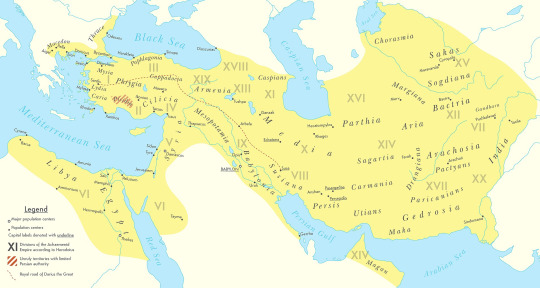


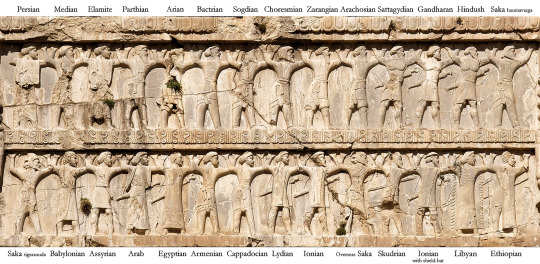
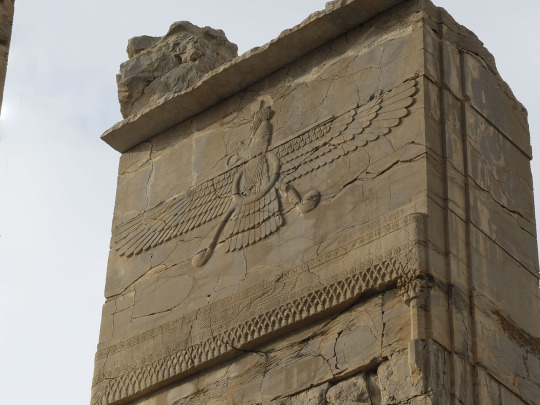
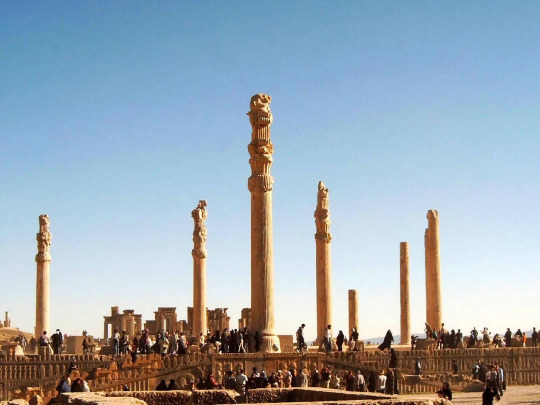

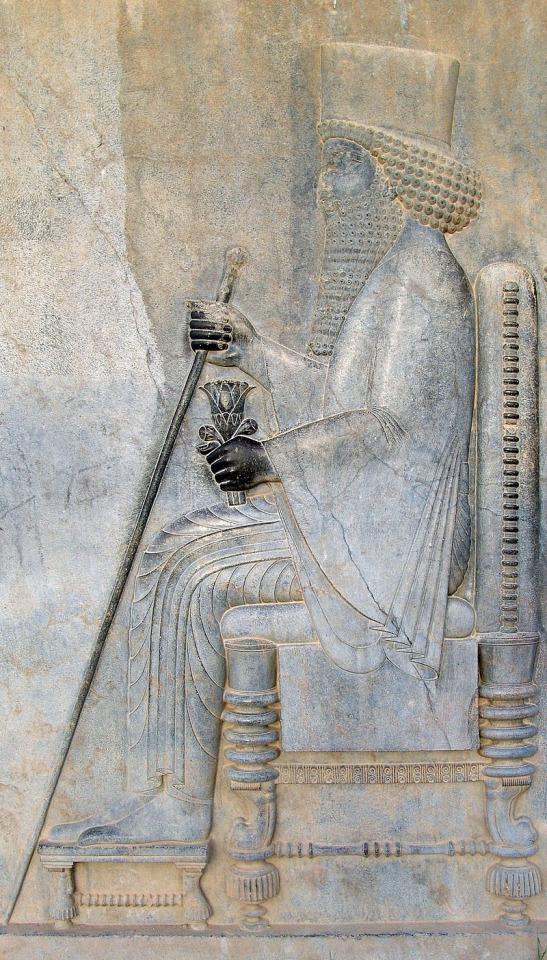

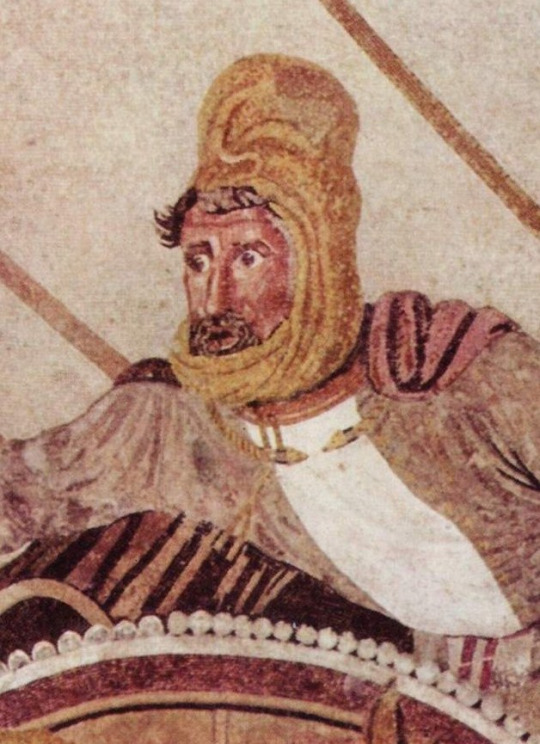
#military history#antiquity#iran#greece#ancient greece#classical greece#ancient ruins#ancient iran#ancient persia#achaemenid#persia#zoroastrianism#alexander the great#cyrus the great#xerxes#artwork#government#history#persian empire#ancient egypt
103 notes
·
View notes
Text
A writer’s guide to forests: from the poles to the tropics, part 7
Is it no.7 already? Wow. A big shout out to everyone who has had the patients to stick with this. Now onto this week’s forest…
Dry forest
Water is life. That’s a fact. And especially where it doesn’t rain for more than half the year.
Location: Dry forests are scattered throughout the Yucatán peninsula ,South America, various Pacific islands,Australia, Madagascar, and India. Areas have been cleared by human activity, and the SA dry forests are classified as the most threatened tropical forests.
Climate: Temperate to tropical, with just enough rain to sustain trees. Many are monsoonal, with rain coming in one or two brief periods separated by a long dry season.
Plant life- Hardy trees, such as Baobab and Eucalyptus are able to last with little rain by tapping into groundwater with extensive root systems. Many trees are evergreen, but in India, many species are deciduous. Trees are often more spaced out, and shrubs and grasses grow extensively. Cacti are common plants in the Americas, with some growing tall enough to be considered trees. In order to survive the heat and lack of water, many small plants are annuals, or store water in tubers. Palms can make up a large percentage of the trees, as was the case in the now vanished forests of Easter Island.
Animal life- As they can come and go when they please, birds are common species. Larger animals are active year round, with smaller species of mammals, amphibians, and certain insects only coming out during the rainy season. Isolation means that islands become home to many endemic species; think about Madagascar and the lemurs, or Darwin’s finches, iguanas, and tortoises in the Galapagos. Isolation has also led to the marsupials of Australia developing to fill the niches that would normally be occupied by placental mammals .The introduction of invasive species has brought about the extinction of island fauna.
How the forest affects the story- Water, or the lack of will be the biggest challenge your characters will face. Rivers and lakes may be seasonal, so other sources will have to be utilized. Drinkable fluids can be obtained from various plants and animals, or maybe the bedrock is porous and water accumulates in cenotes. Your characters could come from a culture that builds artificial reservoirs to collect the rain and store it for the dry season. With careful water management, cities can thrive in dry areas. But your characters will have to be careful. Prolonged drought will see societies go the way of the Maya. Deforestation leaves the topsoil vulnerable to the wind, and forests, farms, and grassland will inevitably turn to desert. Whether nomadic or sedentary, your characters and their society will have to find a way to interact with the forest without destroying it or themselves. Can they do it? Can a damaged biosphere be restored before it’s too late? The success or failure of your characters and/or their predecessors can be a driving focus of the plot. Of course ,when the rains do come, it could be in the form of a cyclone. Dry ground does not readily absorb water, and flash floods are a danger. Water can grant life, but it can take it as well.
#writing#creative writing#writing guide#writing inspiration#writing prompts#writer#writers#writing community#writer on tumblr#writeblr
48 notes
·
View notes
Text
Jamdagni Rishi (Jamlu Devta) Temple Tourist Spot in Malana village, Himachal Pradesh
The Jamdagni Rishi (Jamlu Devta) Temple is a sacred site located in Himachal Pradesh, India, that attracts many visitors seeking spirituality and peace. Nestled amidst stunning mountain scenery, this temple is dedicated to Jamdagni Rishi, who is believed to protect the local people. The area around the temple is filled with offbeat places near Jamdagni Rishi (Jamlu Devta) Temple that offer a glimpse into the rich culture and traditions of the region, making it a must-visit for anyone looking to explore something unique.

When visiting this temple, you can also take a trip to the charming village of Malana, just a short distance away. Known for its distinct culture and traditions, Malana is famous for its local laws and its unique way of life. As you stroll through the village, you'll encounter beautiful stone houses and friendly locals, providing a wonderful opportunity to learn about their customs. There are many places to visit near Jamdagni Rishi (Jamlu Devta) Temple, making this area rich in cultural experiences and natural beauty.
Another lovely spot to explore is the nearby town of Kasol, which is known for its vibrant atmosphere and stunning landscapes. Surrounded by pine trees and the flowing Parvati River, Kasol is a great place to relax or enjoy outdoor activities like trekking and fishing. The area is also popular for its cafes and shops, where you can savor local cuisine and shop for handmade crafts. Whether you’re looking for adventure or simply want to soak in the beauty, the places to visit near Jamdagni Rishi (Jamlu Devta) Temple promise an unforgettable experience!
#clearholidays#Jamdagni Rishi (Jamlu Devta) Temple#places to visit near Jamdagni Rishi (Jamlu Devta) Temple#Jamdagni Rishi (Jamlu Devta) Temple tourism#Jamdagni Rishi (Jamlu Devta) Temple travel guide#Himachal Pradesh#india#indian#travel#india travel#india tourism#incredible india#Malana village#Malana villagetourism#bespoke#beyonce#bibliophile#biology#birblr#birds
0 notes
Text

PAC - What brings joy to you? How to bring joy to yourself?
[please do not copy or reproduce any part of this reading, thank you]
This reading is meant to assist you in connecting with the vibration and experience of joy. While this is for guidance, it is also meant to be fun. These groups are collectives, so take what resonates only!
I'm happy you chose to read this pick-a-pile, and may it bring you closer to the light within you. 🌻
Now slowly take 3 deep breaths. Ask your guardian angel to help you find the relevant pile for you and let your intuition guide you throughout this reading. Enjoy!

---

Pile 1
Signs: pay attention to yourself. apple. justice served. I love you. India, US.
Pile 1!!!! Pile 1, pile 1, pile 1. As I shuffled the cards, I found myself singing. I can bet most of you find joy in singing freely, and even a card fell, backing this up.
I'm also getting that to find joy is to find bliss, and to find bliss is to find joy. That is what joy means to you, pile 1. For you, bliss can be found in your peace and quiet, it can be felt through the divine and experienced during meditations. Being by yourself and not talking, is healing for you. It also helps you to get in touch with yourself as well as your divine team. Again very healing, centering, and therefore it's easier for you to feel that bliss and joy.
Someone here could have a bird or parrot, I think your bird is funny AF and makes you laugh a lot.
Some of you may be close to a grandparent, and so the advice here is to spend time with them as it is a very good way for you to bring joy to yourself (and them!).
We've got the romance card so some of you may feel most joyful when you're in a relationship. But mostly, what I'm getting is that being there for people and supporting them is what brings you joy, always - whatever kind of relationship that is! I feel like you bring out the light within people, the angelic aspect they didn't know they had. That tells a lot about you too, pile 1.
Back to the singing, I also feel like it helps you release a ton of heavy stuff (feelings, painful memories...) that you don't want trapped in you or that you don't want to carry anymore. It also helps you to unleash your true self. There's definitely an element of transformational healing there with singing or songwriting, and the divine is strongly encouraging you to keep doing that.
Some of you could be singing with your own family members. For some, singing is a key characteristic of a side of your family since many generations! How cool is that!!
If you want to purchase a reading from me check my masterlist or go straight to my Etsy listings here. discount code: TUMBLR
---
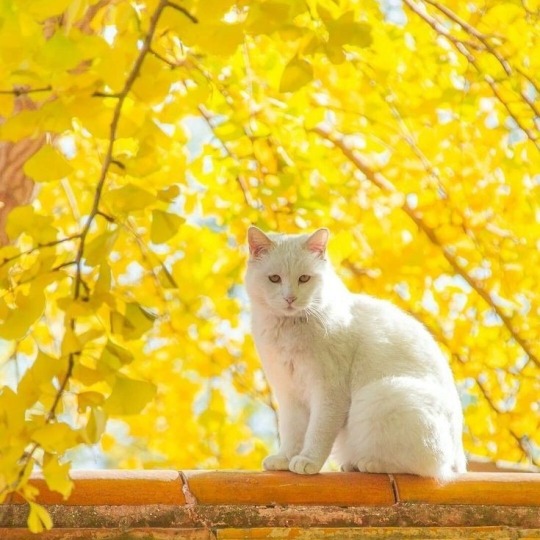
Pile 2
signs: having fun adventures, taking joy in learning, living freely and passionately (see moon & mars in Aries and Sagittarius). Brazil, India, NZ, South Pacific, UK. 44.
I saw deep blue as I was shuffling the cards (in my mind's eye), and sure enough most of the cards had a deep blue in them. I also sensed some sadness from this collective. This deep blue could mean something to you, or it could just represent this sadness of yours.
For this Pile, the divine is asking to bring forth your patience in things, as joy will definitely find you. It seems like you really struggle with it at the moment, so this reading is a welcome guidance for you and I am happy that you chose to read it. :)
For your collective, the divine seems to highlight the importance of patience and growth. They are asking you to cultivate yourself, cultivate discipline/persistence and cultivate patience as good things are headed your way while you practice this cultivation. You could find it useful to listen to monks' wisdom and how they cultivate themselves on patience, discipline, persistence, as well as how they face challenging experiences. Preferably, find books written by them on the subject, as they can freely explain everything. YouTube videos cut many parts out and are nowhere as comprehensive/rich as the monks' own books.
Finally, you are asked to trust yourself as you navigate through the difficult path you are walking on. It is not easy and sometimes you may feel like you are losing balance, but listen; even the whole universe is in a constant fight for balance. Complete balance between the light and the shadow does not exist and that's what makes the universe alive! You are the universe too, you are a spark of God/Creator, and hence it is perfectly normal for you, like all of us, to continually try to find a balance. It's all part of the experience, you beautiful wise soul. And what can be more amazing than knowing that we are alive, that we are all experiencing joys and pains, just like the universe is both made of light and dark..!!
If you want to purchase a reading from me check my masterlist or go straight to my Etsy listings here. discount code: TUMBLR
---
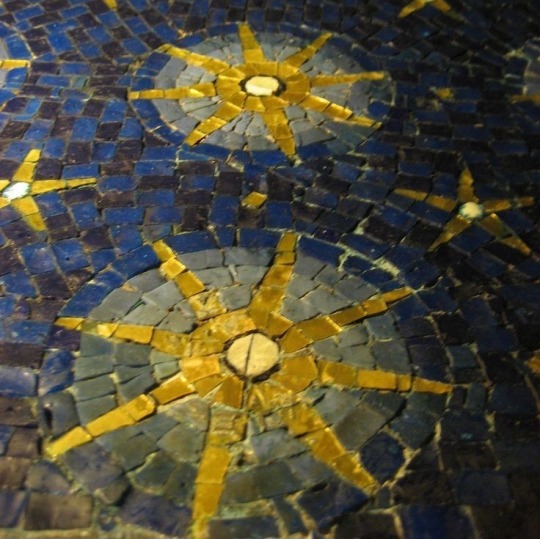
Pile 3
signs: someone is named Grace and it's for a reason - maybe your mother named like this on purpose, Pile 3 you could have a very gentle voice that soothes people, there's a lot of kindness in your voice as I have myself talking this way throughout your reading (yes I talk out loud during my readings). traveling could be a source of joy. US, Australia, UK.
A lot to unpack here (in a good way) but it's also pretty clear to me. It feels like you are Earth angels or Starseeds, I mean to everyone you're literally like a light sent on Earth. You yourself feel like you have a lot of love and care to give to people, so much so that you want to make of it your career. So take it as a sign if that's what you've been thinking about.
The divine are really highlighting that you have a strong connection to your intuition and that a major purpose of it is to be used in service to others. You are divinely guided, and you definitely have your own mission or purpose in this life on Earth, which is to assist and guide others towards their inner light, their inner spark of Creator/Source.
You may be hesitating at the moment but trust your intuition, you will find joy on the path that the divine accompanies you on. Worry not, whatever path you chooses, the divine will always support you. However this reading is about what brings you joy and how you can bring joy to you. ;)
Now that's out of the way, let me indulge in the feeling I got from you Pile 3! It's a secret shh, but you're my favourite pile of the 3! xD
I got this really sweet, caring and loving energy from your collective, it's beautiful! Your spark is really focused on assisting others, which makes me think you're more likely an angelic aspect than a starseed. You love others but you also let others love you - and by letting them love you, you are helping them to nurture and express these energies more! In other words, people feel safe to express these caring energies towards you as well.
In terms of vibration, love and joy are not so far off from each other and they are actually interconnected, aren't they? :)
So there you go Pile 3, keep true to yourself and your values, keep shining your light (love) inside out, keep hugging others within your angel wings ~
If you want to purchase a reading from me check my masterlist or go straight to my Etsy listings here. discount code: TUMBLR
---
Obviously, this type of reading is amazing to do because you're bathing in the energy you're reading about! Amazing. Again I hope you enjoyed. Let me know what piles you got and what your thoughts are~
Thynisia <3
This reading was done partly through cartomancy, divine channeling and my personally made paper note signs. I thank Source, Gaia, and all of our higher selves and guardian angels for supporting and blessing this reading. 🙏🏼
#oracle#tarot#card reading#divination#pick a card#tarot reading#oracle reading#pac#pick a pile#psychic reading#channeling#healing#joy#yellow#yellow aesthetic#pick a group#pick a picture#pick an image#confirmation signs#thynisia#angel#starseed#divine guidance#happiness#tarotblr#tarot community#free reading
68 notes
·
View notes
Text
Legendary Creatures: Personification of Death

By Jbuzbee - Own work, CC BY 3.0, https://commons.wikimedia.org/w/index.php?curid=4835571
Many cultures have a representation of death, either as the cause of a person's death through the removal of the person's soul or as a guide to the afterlife (a psychopomp). Death is often also the guardian of dead bodies. Throughout this death as the end of life will be minuscule and Death as a personification will be majescule.
By Region:
Latin America:

By Unknown author - 1898 facsimile edition, online at FAMSI.org, Public Domain, https://commons.wikimedia.org/w/index.php?curid=3975254
Aztecs view Death as a Queen of the Underworld (Mictlan), Mictecacihuatl, ruling over it with her husband Mictlantecuhtli. The Lady of the Dead, who was represented by a 'fleshless body…with jaw agape to swallow the stars during the day', also kept watch over bones. Her ancient festivals morphed into the modern Dia de los Muertos as the Catholic colonizers took over.
East Asia:

By Unknown author - Source:Yama's Durbar and HellSize: 52 x 37.7 cm.Tempera on cloth pasted on wooden plank.Fine lines and beautiful colouring. It is probably from Kurnool.Purchased in 1924. Museum collection of Government Museum Chennai[1], Public Domain, https://commons.wikimedia.org/w/index.php?curid=15973687
In India, Death is King Yama (यम राज, Yama Rāja) also is the King of Karmic Justice (Dharmaraja). He rides a buffalo and lassos the soul to lead it to his home Naraka. He also has aids called Yamadutas (यमदूत) that bring in souls as well. King Yama judges the souls and decides what their next life should be or if they've reached moksha/nirvana (मोक्ष/निर्वाण).

By Riku Chuen 陸忠淵 - http://www.emuseum.jp/detail/100087, Public Domain, https://commons.wikimedia.org/w/index.php?curid=42896906
Yama (閻魔/閻摩), also known as King Yan (閻王/阎王) or Yanlou (閻羅王/阎罗王), came to China via Buddhism and ruled over the ten gods of Diyu (the underworld). He typically wears a judge's cap with the character 王 (king) on it. He determines the path that a soul will take, whether good fortune or suffering, before being returned to earth in the cycle of reincarnation.

By Originally uploaded on sv:wiki 10 April 2005 kl.18.50 by Lamré - From sv.wikipedia.org., Public Domain, https://commons.wikimedia.org/w/index.php?curid=626913
Yama entered Japan as the Greak King Enma (閻魔大王). He was only the judge. The personification of death was Izunami (formally Izanami-no-Kami 伊弉冉尊 or Izanami-no-Mikoto 伊邪那美命), who was burnt to death while she gave birth to the god of fire, Hinokagutsuchi. She's sent to Yomi-no-Kuni (the realm of night) where her husband Izanagi tries to rescue her but finds her no longer beautiful. They fight and she swears to take a thousand lives every day, becoming Death. She tives birth to Raijin (the god of lightning, thunder, and storms) and Fuujin (the god of the wind). There are minor death gods called shinigami (死神) that take care of the more personal tasks of death.
Western Asia:

By Rama - Own work, CC BY-SA 2.0 fr, https://commons.wikimedia.org/w/index.php?curid=2994550
Among the Canaanites of the 13th century BCE, Mot (Phoenician 𐤌𐤕 mūt Hebrew מות māweṯ Arabic موت mawt) was the psychopomp and god of the underworld. He is a son of 'El (the supreme god) and lives in a city called Mirey (hmry). Ba'al (Hadad, the storm and rain god) warned the other gods 'that you not come near to divine Death, lest he make you like a lamb in his mouth, (and) you both be carried away like a kid in the breach of his windpipe'. Ba'al is devoured by Mot, then buried by Shapash, goddess of the sun, and 'Anat, his sister and goddess of warfare and hunting, 'Anat attacks Mot, splitting him with a blade, winnowing (tossing him up in the air and sifting what remains), burns him up, then grinds him up before tossing him in a field for the birds to eat. 'El (also Ba'al's father) dreams that Ba'al is alive and sends Shapash to disinter him. Seven years later, Mot comes back, seeking his vengeance on Ba'al until Shapash warns Mot that 'El will take away his throne if he doesn't knock it off, so he does.

By Evelyn De Morgan - Transferred from en.wikipedia to Commons by User:Melesse using CommonsHelper. and [1], Public Domain, https://commons.wikimedia.org/w/index.php?curid=4394578
Among the Hebrews, Death is seen as an 'Angel of the Lord' who passes though camps and nations to slay their enemies, and as a 'destroying angel' and as Azra'il (עֲזַרְאֵל ʿǍzarʾēl, 'God has helped') and 'Abaddon' (אֲבַדּוֹן Ăḇaddōn, 'Destruction' or 'doom'). Death could also be another god that God could turn over Judah to as punishment for worshiping other gods, the group of angels, at times, that destroy those not protected by the guardian angels. It was thought that the soul escaped through the mouth, so Death waits by the head of the person. A cry goes around the world, even if people can't hear it. Death may wield a sword, a knife, a noose (cord), or hot lead. Death is also a shape-shifted, taking on the form most needed at the time. Gradually, this became six angels of Death, 'Gabriel over kings; Ḳapẓiel over youths; Mashbir over animals; Mashḥit over children; Af and Ḥemah over man and beast', which seems an extension of the shape-shifting ability.

By Gustave Doré - http://thelondondiary.wordpress.com/2007/12/22/gustave-dore/, Public Domain, https://commons.wikimedia.org/w/index.php?curid=9048383
Among early Christians, they adopted the form of death that was local to them as well as that presented in the Book of Revelations, where Death (Thanatos, as early Christian writers were very Hellenized) is one of the horsemen of the apocalypse. And the apostle Paul states 'O Death, where is your sting' in the first letter to the Corinthians. They viewed Death as impotent to them since they expected that the world would end soon and they would be granted Heaven (a type of paradise reserved for those who follow the teachings of Jesus). Sometimes, as in the book addressed to the Hebrews, the power of death is held by the devil (the spiritual enemy of believers). At the end of the mortal realm, after the apocalypse, Death is to be destroyed.

By Zakariya ibn Muhammad Qazwini (ca. 1203-1283)Muhammad ibn Muhammad Shakir Ruzmah-'i Nathani - Walters Art Museum: Home page Info about artwork, Public Domain, https://commons.wikimedia.org/w/index.php?curid=18854360
In Islam, the Archangel Azrael (عزرائيل) is the Malak al-Maut (angel of death) and is in charge of many others that do the work of removing souls from bodies and guiding them through their journey. Their exact appearance will depend on the type of life the person lived (beautiful for the good, for example). After the body is buried, two angels, Munkar and Nakir (منكر ونكير, 'The Denied and The Denier'), who test the dead and determine their afterlife. If the person answers correctly, they go on to live in peace, else wise, they are punished. Death itself is seen just as a transition rather than an ending.
Europe:
Greece:

By Jaime Ardiles-Arce (photographer). Krater by Euphronios (painter) and Euxitheos (potter). - File:Euphronios krater - front.jpg, Public Domain, https://commons.wikimedia.org/w/index.php?curid=9746343
Thanatos (Θᾰ́νᾰτος) is the son of Nyx (Νύξ personification night), though he and his brother Hypnos (Ὕπνος personification of sleep) usually have no father, though sometimes Erebus (Ἔρεβος personification of darkness). According to Hesiod, the sun 'never looks upon them [Hypnos and Thanatos], And the former of them roam peacefully over the earth and the sea's broad back and is kindly to men; but the other has a heart of iron, and his spirit within him is pitiless as bronze: whomsoever of men he has once seized he holds fast: and he is hateful even to the deathless god'. The only person recorded as escaping Thanatos is Sisyphus, who tricked Thanatos into chaining himself up, preventing anyone from dying for a time, until Ares (Ἄρης god of war) released him. Next, Sisyphus convinced Persephone (Περσεφόνη queen of the underworld) to release him so that his wife could have a proper funeral for him. It took Hermes dragging Sisyphus to Tartarus and setting him to work rolling a boulder up a hill until it rolled back down before it reached the top. As the idea of Elysian Fields (Ἠλύσιον πεδίον, a type of paradise reserved for heroes and the upright and chosen) developed, Thanatos became less feared and more beautiful and gentle.
#death#yama#thanatos#azrael#mot#enma#mictecacihuatl#dia de los muertos#psychopomp#afterlife#legendary creature
7 notes
·
View notes
Text
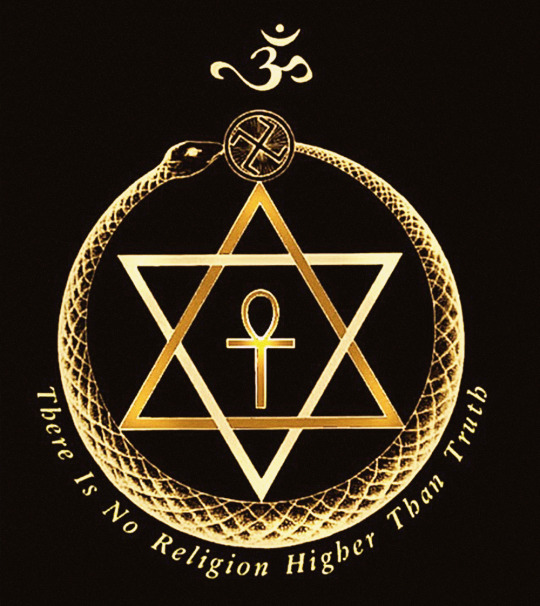

"All religious forms are manifestations of the great cosmic, universal, infinite religion latent in every atom of the cosmos." --Samael Aun Weor - The Perfect Matrimony
Any genuine religion, mystical tradition, or type of spirituality is an attempt to communicate something of value and importance, which is that there is a purpose to life that one can experience for oneself.
The main traditions that we study here are Hinduism, Judaism, and the reform of those religions which came later, which are Buddhism and Christianity. We study all religions, but these are the four main ones we are interested in.
There are people all over the world that study the religion that they grew up with, or the religion that they became attracted to during their life. All of those traditions are very beautiful and have a great deal of knowledge that they express to humanity.
But unfortunately, people do not see religions for what they truly are. Over many centuries, religions have become a mere belief, something that people follow, respect, study and believe in, but rarely experience. It is very rare, sadly, to find anyone who has true experience of what the religions are teaching. Yet, that is their purpose: to guide us to experience what they teach.
In this tradition, the experience of religion is our primary goal. Our primary interest is learning the practical value of each religion.
Now in the case of Buddhism, Hinduism, Judaism and Christianity, all of them in their essence teach exactly the same thing. On the surface they can appear different, but in their heart they are exactly the same.
They are attempting to convey the experience of a higher way of living, something that cannot be communicated in words. Each religion is like the expression of direct mystical experience with the divine.
Jesus was a vessel for that spirit which came in order to teach the same thing, the same religion, the same truth in different places. As an example: in India we find the Lord Krishna, who taught the same truth, in different levels of course, according to its own vessel. The vessel of Krishna who is one with that Spirit and is that same Spirit itself is the Bodhisattva; the Bodhisattva of Krishna is of course Arjuna, who we find in the Bhagadvad Gita.
Arjuna is the one who is talking to the Lord Krishna in the Bhagavad Gita, but you have to understand that Arjuna is the bodhisattva of Krishna. So, Krishna is the master of Arjuna. Krishna is the master and Arjuna is the Bodhisattva, who is learning from him and is at the same time teaching to others through the same.
The thing is that when we talk about this spiritual prophecy, or this intelligence that is able to incarnate in many places in order to establish the religion or the way to union with God of that time and place, this concept is understood in the western world, through the Bible, but in a very incomplete way.
Indeed, in the West there is a lot of ignorance related with this spirit, because in many different places this spirit has received many names. Among the Tibetans, for instance, Christ is known as Avalokiteshvara; you find that name in the Buddhist Pantheon.
Among the Taoists you find Kwan Yin. Kwan Yin is of course, according to the Tao, the “subtle voice,” or the “sweet voice,” in other words, the verb, the word, Logos.
Among the Mayans, they call this spirit, Kukulkan. The word “Kukul” means bird and “Kan” means serpent. So, when you say Kukulkan, this means the “bird-serpent.” That spirit, the “bird-serpent” in Aztec language or Nahua, is Quetzalcoatl.
There among the Peruvians, the Incas of Peru they call him Viracocha. Viracocha is the same Vishnu, the Lord. Of course, Chokmah חכמה, in the Kabbalah as you know means “Wisdom” and this is related with this spirit of wisdom.
All religions are precious stones strung on the golden thread of Divinity.
All religions conserve the eternal values. False religions do not exist.
All religions are necessary; all religions fulfill their mission in life.
It is absurd to state that our neighbor’s religion is useless and that only ours is authentic. If the neighbor’s religion is not good then my religion is not good either because the values are always the same.
It is stupid to state that the religion of the indigenous tribes of America is idolatry because they too have the right to say that our religion is idolatry. If we laugh at them, they can also laugh at us. If we say that they adore or that they adored idols, then they too can say that we adore idols.
We cannot discredit the religion of others without discrediting ours as well because the principles are always the same. All religions have the same principles.
Under the sun, every religion is born, grows, develops, multiplies into many sects, and dies. This is how it has always been and will always be.
Religious principles never die. The religious forms can die, but the religious principles, in other words, the eternal values, can never die. They continue; they are re-dressed with new forms.
Religion is inherent to life in the same manner that humidity is to water.
It is worthwhile to study all religions. The comparative study of religions leads one to comprehend that all religions conserve the eternal values, that no religion is false, that all are true.
The word religion comes from the Latin word religare, which implies “to link or bind or union of the Soul to God."
"As the blazing fire reduces wood to ashes; similarly, the fire of Self-knowledge reduces all bonds of karma to ashes..." --Krishna - Bhagavad-gita 4:36-37
The eternal values embodied in the world's religions express the essential requirements for the consciousness to enter into the light and fully realize the purpose of living.
In other words, the heart message of every religion seeks to awaken the consciousness and eliminate suffering, so that the eternal light may be known through our own direct experience.
"Truth is one; sages call it by various names." -- Rig Veda
Original Post by Mac Fion
14 notes
·
View notes
Text
Exploring the Kuari Pass Trek by a Journey to the Heart of the Himalayas
With its stunning mountain vistas, unique forests, and an unforgettable experience in the great outdoors, the Kuari Pass Trek is one of the most beautiful trekking routes in the Indian Himalayas. This trek perfects itself for adventurers who want to dip into the wonders of nature. Heaven Riders India, the trusted name in Himalayan trekking, takes the trekkers on this journey by ensuring their safety while leaving behind a memorable experience among the mountains. I will give an in-depth look on what makes Kuari Pass Trek so appealing to all nature lovers and adventure goers.
Why Choose the Kuari Pass Trek?
The Kuari Pass Trek is one of the best treks in Uttarakhand, targeting any individual interested in a mix of wonderful scenic landforms and moderate treks. Popularly known as the “Lord Curzon Trail” after Lord Curzon who pioneered the route in the early 1900s, the trek boasts breathtaking views of majestic Himalayan peaks including Nanda Devi, Dronagiri, Chaukhamba, and Kamet. Heaven Riders India brings the best of this trek with their knowledgeable guides, comfortable arrangements, and a commitment to safety, making it perfect for both beginner and seasoned trekkers.
The Unique Beauty of Kuari Pass
Varied landscapes of Kuari Pass make trek very interesting for trekkers when they experience the Himalayas. From the dense forests of oak and rhododendron trees, vast meadows and lush valleys open up the trail. So, this trek does not get boring, and with each turn, new views reveal the picturesque beauty of nature.
One of the apotheosis moments of the trek is the view from atop the Kuari Pass, which offers a stunning view of towering peaks. Heaven Riders India makes sure the trekkers are having the best experience possible-to “push” them to the best viewpoints while training them in the region’s natural and cultural history.
An Itinerary Crafted by Heaven Riders India
The Kuari Pass Trek takes around 5-6 days according to the route taken. Heaven Riders India plan an itinerary which will balance a great degree of adventure trekking with proper rest and acclimatization so that trekkers enjoy the journey fully.
Arrival and Acclimatization: It starts from Joshimath where Heaven Riders India would ensure that the start day is amiable. Acclimatization to the altitude would be a critical factor for the successful trek.
Trek to Gulling: The initial day of trekking takes you through the lush forests and small mountain villages, giving a glimpse of local life. The guides of Heaven Riders India make sure that the trekkers are comfortable; they point out scenic spots on the way.
Gulling to Tali Top: The trek takes the route through oak and rhododendron forests. Sometimes trekkers get rare birds, even wildlife, making the adventure exciting.
Summit Day – Kuari Pass: TThe peak of the climb is at the pass. Heaven Riders India cannot take anything on the strength of chance, but instead, a safe and steady pace and guiding trekkers up to the summit where breathtaking views are located. A view of the stretch of snow-clad peaks right around the horizon is a memory to forever keep.
Return to Joshimath: After having drowned in the beauty of Kuari Pass, trekkers wander back downhill, passing through stunning trails and celebrating the achievement of the trek.
What Makes the Kuari Pass Trek Special?
The Kuari Pass trek is special for many reasons and Heaven Riders India adds to it with expertise and dedication. Here’s why the trek experience is unique:
Stunning Himalayan Views: Catch the view of peaks like Nanda Devi and Dronagiri as viewed during the trek.
Rich Flora and Fauna: The trek passes through dense forests of oak and rhododendron trees. Other species of very rare birds and animals can be seen; therefore, it is an exciting adventure for nature lovers.
Local Culture and Villages: The Kuari Pass Trek is also a cultural excursion. This enables the trekkers to get into contact with the people and experience mountain life.
A Great Option for Beginners:Although it is considered not too challenging in terms of difficulty, Heaven Riders India makes the Kuari Pass trek quite accessible to beginners as it sets a comfortable pace and offers assistance all throughout the trek.
Preparing for the Kuari Pass Trek with Heaven Riders India
Heaven Riders India equips the trekkers with detailed advice on what to carry, workout routines, and how one should prepare for high-altitude trekking. Here are a few things to take care of:
Fitness Level: The trek is moderately challenging but would require a minimum fitness level. Heaven Riders India asks the trekkers to regularly do cardio and leg strengthening exercises to ensure they enjoy the trip without much trouble.
Packing Essentials:The Himalayas’ weather is changing, hence Heaven Riders India requests the trekkers to carry layers of warm clothes, waterproof clothing, comfortable shoes for trekking, and personal requirements such as sun protection cream, first-aid kits, and enough water.
Acclimatization: Heaven Riders India avoids altitude sickness by having rest days included in the itinerary and advises slow walking, hydration, and abstaining from alcohol.
Why Choose Heaven Riders India for the Kuari Pass Trek?
One genuine company, such as Heaven Riders India, would be your safest bet for an enjoyable and memorable experience while trekking. Here is how they differ:
Experienced Guides: The company offers keen, friendly, knowledgeable guides who know the terrain well, thus ensuring that the trekkers have a thought-provoking and safe journey.
Focus on Safety: Heaven Riders India is not anything careless with safety as they have reduced group sizes, staff training in basic first aid needs, proper guidance to bring risks to a minimal.
Eco-Friendly Practices: Heaven Riders India ensures sustainability in tourism and contributes to activities that care for the environment, including minimal plastic usage and zero waste.
Community Engagement: Heaven Riders India is pro-community. They are able to support the local community’s economy while making trekking experiences authentic.
Experiencing the Magic of the Kuari Pass Trek
Trek to Kuari Pass is much more than just a trek in mountains; it provides an opportunity to connect with nature, beautiful landscapes, and new visions. Because Heaven Riders India makes sure that all aspects of authenticity and enjoyment are featured in the trek, such an experience can be very rewarding. From day one of planning to summit day, they take care of all details so that the trekkers have enough time to enjoy every single moment.
Conclusion
Kuari Pass Trek with Heaven Riders India would be an excellent choice if you seek one unforgettable Himalayan adventure. A combination of breathtaking landscapes, cultural exposure, and well-organized support will make this trek an experience of a lifetime. So, pack your bags, lace up your boots, and join Heaven Riders India on an exciting sojourn through the trials of the immensely beautiful and thrilling Kuari Pass Trek-a journey that will forever be etched in your heart as a sojourn in the great Himalayas.
Originally Published Here:-
2 notes
·
View notes
Text
Ranthambore National Park: A Journey into India’s Wildlife Haven
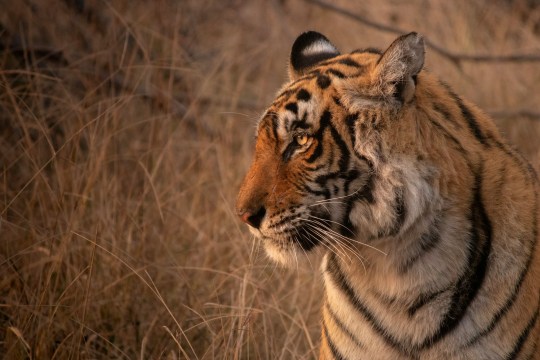
The Allure of Ranthambore National Park: A Wildlife Wonderland
Ranthambore National Park, situated in the vibrant state of Rajasthan, is a captivating destination that offers an extraordinary glimpse into India’s wildlife heritage. Known for its dramatic landscapes and diverse ecosystems, this national park is a dream come true for nature enthusiasts and adventure seekers alike. Here are some compelling reasons to visit Ranthambore.
1. Encounter the Iconic Bengal Tiger
Ranthambore is one of the premier locations in India for spotting the elusive Bengal tiger. The thrill of observing these magnificent creatures in their natural environment is unmatched. From the excitement of a tiger sighting during a safari to hearing their distant roars echoing through the jungle, every moment spent in the park is filled with anticipation.
2. Diverse Wildlife Experience
Beyond tigers, Ranthambore is home to a rich variety of wildlife. The park is teeming with species such as leopards, sloth bears, wild boars, and over 300 bird species. This incredible biodiversity makes it a paradise for wildlife lovers and bird watchers, providing endless opportunities for exploration and discovery.
3. Stunning Natural Landscapes
Ranthambore's breathtaking landscapes are a feast for the eyes. The park features a unique blend of rugged hills, lush forests, and tranquil lakes, creating a picturesque backdrop for your adventures. The ancient Ranthambore Fort, perched high on a hill, offers stunning views of the surrounding wilderness and adds a historical touch to your visit.
4. Adventure Awaits
For those seeking adrenaline-fueled experiences, Ranthambore has plenty to offer. Jeep safaris and canter rides allow you to traverse the park’s diverse terrain and get up close to its wildlife. Additionally, guided nature walks provide a more intimate way to explore the flora and fauna, perfect for photographers and nature lovers.
5. Rich Cultural Experiences
Ranthambore is steeped in culture and tradition. The surrounding villages offer visitors a chance to experience local customs and lifestyles. Engage with friendly locals, taste authentic Rajasthani cuisine, and shop for unique handicrafts. These cultural encounters enrich your journey and provide insight into the vibrant heritage of the region.
6. Tailored Tour Packages
To ensure a seamless experience, consider booking a tour package that caters to your interests. Various options are available, including wildlife-focused safaris and cultural explorations. For comprehensive travel packages designed to enhance your visit, check out Indian Inspire Journey's Ranthambore tour packages. These packages make it easy to navigate the park’s offerings, allowing you to relax and enjoy your adventure.
7. Commitment to Conservation
Ranthambore National Park is a shining example of successful wildlife conservation. By visiting, you support efforts to protect the region's unique ecosystems and promote sustainable tourism. Your trip helps ensure that future generations can experience the wonders of Ranthambore.
Conclusion
Ranthambore National Park is a remarkable destination that combines thrilling wildlife encounters, stunning landscapes, and rich cultural experiences. Whether you’re a wildlife enthusiast, a photographer, or a curious traveler, Ranthambore promises an unforgettable adventure. To start planning your journey, explore the Ranthambore tour packages offered by Indian Inspire Journey and prepare for an experience that will leave you in awe of nature’s beauty.
2 notes
·
View notes